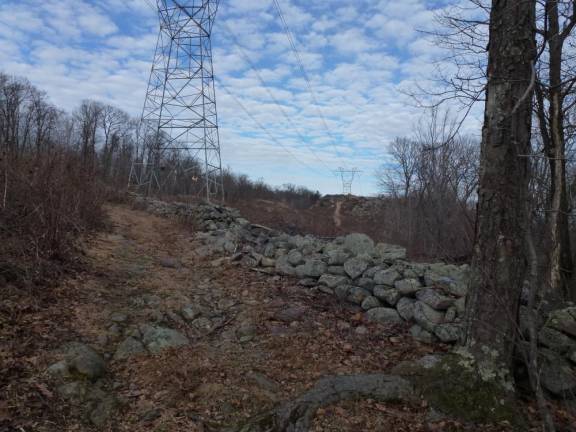The wonders underfoot
Our stone walls tell a story that streches from Napoleon to Smartwool



Tom Wessels stands next to a stone wall at the start of his Reading the Forested Landscape YouTube series. Sporting a frizzy white beard extending to his sternum, he appears to be your usual Northeastern mountain man. But in his my-favorite-professor voice, he’s talking about the invasion of Spain.
There are times when the familiar snaps into focus in a particularly thrilling way. Imagine suddenly being able to understand a conversation overheard during a sojourn in a foreign country, or to look at the notes arrayed on a staff and hear their music. Listening to Wessels unspool his story, about details in the woods so familiar they may as well be etched on my palm, was one of those times.
Napoleon’s dyspeptic visage fills the screen. Without him, this stone wall in the middle of the woods, and countless others, would not exist. After his soldiers invaded in 1808, Spain lost proprietary control over its Merino sheep, prized worldwide for their ultra-soft wool. A wily Vermonter was thereby able to smuggle 4,000 of the animals back to his home state. If you wear Smartwools, Wessels says, you’ve got some Merino in your sock drawer.
Hot damn. Of course I wear Smartwools. I’m wearing them right now!
And so, he continued, Sheep Mania began. It turned the self-sustaining farms of our early history into our first market farms. With farmers striking it rich, a “religious fervor” took hold. Soon, all the terrain below 2,000 feet was cleared for sheep pasture. Farmers preferred split rail fences to contain their animals but, after the clearing frenzy, had to resort to their rock dumps when the rails needed replacing. By the time Sheep Mania peaked in about 1840, it had spread from New England to, among other places, Pennsylvania and New York.
Wessels brings home the immensity of this feverish stone-moving effort. “If we piled all this stone, it would be six times as massive as all the pyramids in Egypt, and yet it was all done in just about 30 years.” And that’s just the walls in central New England. If they were located on the Mediterranean, he says, “I’m convinced it would be the eighth wonder of the world.”
Wessels is a terrestrial ecologist and professor emeritus at Antioch University New England. And he doesn’t stop with rock walls. In his film series, his book of the same name, and his field guide Forest Forensics, he offers a CSI for the outward-bound. Every seemingly insignificant detail tells a sweeping story. If the ground appears smooth, it has once been cleared for pasture or crops. If it’s bordered by lots of small, fist-sized rocks, it was once a crop field (“Cultivation is the only activity that generates, then necessitates, the removal of small stones,” Wessels says). A big old tree surrounded by small ones will have once shaded animals in a pasture – the only reason to let a tree grow on cultivated land. These “pasture trees” provide huge benefits for wildlife, but they are fading into history. You can be sure I won’t pass another one without paying my proper respects.
And that fallen trunk, is it a deadfall or a blowdown? The latter marks the passage of a storm. Wessels tracked several blowdowns – including those whose once massive root balls have been reduced to “pillows” of soft earth overlooking the “cradles” left when they uprooted – to well-documented storms of the 19th and early 20th centuries.
Wessels’ big picture approach even lends some rare comfort in these times of compounding environmental crises. When I moved to the Upper Delaware in the 80s, my 90-something neighbors shared cherished memories of the chestnut trees that were once so plentiful, the hills looked snow-covered when they bloomed. They were sorry I’d never get to see such a sight. But Wessels is confident future generations will. The mature, established chestnuts all died in the early 20th century. But the chestnuts that were young when the blight struck keep mounting comebacks. In some distant time they will recover their glory, when the tree and the blight learn to live together.
So, I’m heading out with Forest Forensics to the many local trails I think I know well but want to see with new eyes. For rock walls, the Appalachian Trail in either direction from Wawayanda State Park, along the New York/New Jersey border, is a good bet. Go south, and you’ll reach the Pinwheel Vista, overlooking Vernon, by lunch; go north, and you’ll get to the ridge overlooking Greenwood Lake.
But I may just spend my lunch contemplating a mossy stump, a Rosetta stone ready to reveal its secret. I’m not as interested now in the wide views as I am in the small details that tell the big story.
SNEAK PEAK
Trailhead: Wawayanda State Park, 885 Warwick Turnpike, Hewitt, N.J.
Trail: Appalachian Trail (white blazes) to Pinwheel Vista, 9.2 miles round-trip; to Greenwood Lake overlook (Prospect Rock), 7.8 miles round-trip.